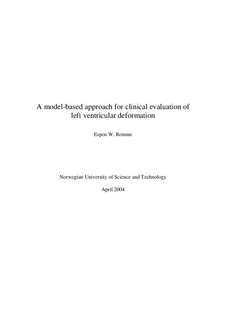| dc.contributor.author | Remme, Espen W. | nb_NO |
| dc.date.accessioned | 2014-12-19T13:29:36Z | |
| dc.date.available | 2014-12-19T13:29:36Z | |
| dc.date.created | 2004-06-08 | nb_NO |
| dc.date.issued | 2004 | nb_NO |
| dc.identifier | 124854 | nb_NO |
| dc.identifier.isbn | 82-471-6303-9 | nb_NO |
| dc.identifier.uri | http://hdl.handle.net/11250/249759 | |
| dc.description.abstract | Assessment of left ventricular (LV) deformation is essential for clinical evaluation of LV function and cardiac images are frequently used to evaluate the LV motion and function. By combining the images with mathematical models more information may be extracted from the images. The work presented in this thesis has focused on using the finite element (FE) method to describe the LV and its deformation and combining this method with images of the heart to extract more information about the deformation.
We developed a method that estimated the LV deformation by manually tracking distinct anatomical landmarks (fiducial markers) through the cardiac cycle in 3 dimensional (3D) images of the heart. The motion of the nodal parameters of an FE mesh shaped to the geometry of the LV was fitted to the motion of the fiducial markers and thus provided a means to describe the motion. The sparsity of the fiducial markers made the fitting problem under-constrained so a parameter distribution model (PDM) of likely motions were constructed from a historical database of cases where FE meshes had been fitted to the motion of magnetic resonance (MR) tagged data. The estimated deformation from the fiducial marker fitting was filtered through the PDM and the resulting deformation corresponded well when compared to the deformation obtained from MR tagging in 13 normal subjects.
A method that decomposed the LV deformation into different deformation modes such as longitudinal shortening, wall thickening, and twisting was developed. The nodes of a subject’s LV FE mesh were displaced according to each deformation mode and the relative contribution of each mode to the total deformation measured by MR tagging was quantified by calculating a coefficient for each mode. A study that compared 13 young normal subjects with 13 older diabetes patients showed that the patients had a significantly lower degree of longitudinal shortening and wall thickening but a higher degree of longitudinal twist.
The LV deformation is influenced by cardiac disease via the material properties of the myocardium. We investigated the effects of the material parameter values on the LV deformation in a simulation study using an FE model of the LV. A description of the myocardial microstructure and a passive and active constitutive law was included in the model. The cardiac cycle was simulated from the beginning of diastasis through to the end of ejection by applying appropriate boundary conditions. The different deformation modes between end diastole and end systole were extracted and quantified for different sets of material parameters. We found that stiffer material properties particularly in the myocardial sheet direction impaired longitudinal shortening and wall thickening.
A sensitivity analysis was carried out to look at the various material parameters’ influence on LV wall strains during passive inflation. The analysis showed a high degree of coupling of the parameters in the constitutive law, which indicated an overparameterization of the law. A parameter estimation study revealed the same problem. Most of the parameters were set to constant values and only one parameter in each of the three microstructural directions were estimated during the passive inflation phase using synthetic strain data as measurements. This still gave good estimates of the stress-strain relationships in the fiber and sheet directions. | nb_NO |
| dc.language | eng | nb_NO |
| dc.publisher | Fakultet for informasjonsteknologi, matematikk og elektroteknikk | nb_NO |
| dc.relation.ispartofseries | Doktoravhandlinger ved NTNU, 1503-8181; 2004:48 | nb_NO |
| dc.relation.haspart | Stevens, C; Remme, E; LeGrice, I; Hunter, P. Ventricular mechanics in diastole: material parameter sensitivity. Journal of Biomechanics,. 36: 737-748, 2003. | nb_NO |
| dc.relation.haspart | Remme, EW; Hunter, PJ; Smiseth, O; Stevens, C; Rabben, SI; Skulstad, H; Angelsen, B. Development of an in vivo method for determining material properties of passive myocardium. Journal of Biomechanics. 37(5): 669-678, 2004. | nb_NO |
| dc.relation.haspart | Remme, EW; Young, AA; Augenstein, KF; Hunter, PJ. Extraction and quantification of left ventricular deformation modes. IEEE Transactions on Biomedical Engineering. 51(11): 1923-1931, 2004. | nb_NO |
| dc.relation.haspart | Remme, EW; Hunter, PJ. The influence of material properties on left ventricular deformation in an elliptical model. . | nb_NO |
| dc.subject | Engineering cybernetics | en_GB |
| dc.title | A Model-based Approach for Clinical Evaluation of Left Ventricular Deformation | nb_NO |
| dc.type | Doctoral thesis | nb_NO |
| dc.source.pagenumber | 90 | nb_NO |
| dc.contributor.department | Norges teknisk-naturvitenskapelige universitet, Fakultet for informasjonsteknologi, matematikk og elektroteknikk | nb_NO |
